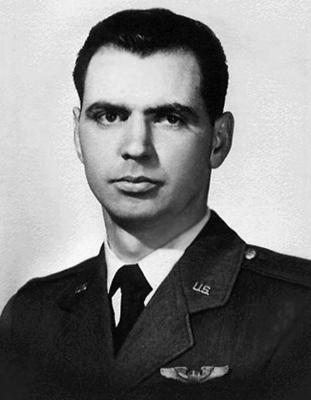

Edmund Francis Thornell
21st Tactical Air Support Squadron
505th Tactical Control Group 7th Air Force
Attached to HHC 1/22 Infantry
KIA 09/10/1966
PERSONAL DATA:
Home of Record: Redondo Beach, CA
Date of birth: 09/10/1933
MILITARY DATA:
Service Branch: United States Air Force
Grade at loss: O3
Rank: Captain
Promotion Note: None
ID No: 53783
MOS or Specialty: -----: Not Recorded
Length Service: 14
Unit: 21ST TAC AIR SPT SQDN, 505TH TAC AIR CTRL GROUP, 7TH AF
CASUALTY DATA:
Start Tour: Not Recorded
Incident Date: 09/10/1966
Casualty Date: 09/10/1966
Age at Loss: 33
Location: Phu Yen Province, South Vietnam
Remains: Body recovered
Casualty Type: Hostile, died outright
Casualty Reason: Fixed Wing - Crew
Casualty Detail: Air loss or crash over land
Captain Edmund F. Thornell was
piloting a Cessna O-1E Bird Dog aircraft number 56-4184
while on a Forward Air Controller reconnaissance mission for 1st
Battalion 22nd Infantry
when his aircraft was struck by enemy ground fire from a .50 or
.51 caliber heavy machine gun.
His aircraft crashed inland, at grid coordinates CQ 300302,
approximately 250 yards from the sea,
about ten miles south of Tuy Hoa Air Base in Phu Yen Province.
He was killed in action on his 33rd birthday on September 10, 1966.
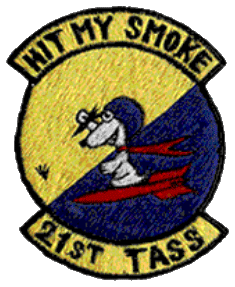
Pocket patch of the 21st Tactical Air Support Squadron
Edmund F. Thornell was born in Stoughton, Norfolk County, Massachusetts on September 10, 1933.
He entered military service on June 29, 1951.
Captain Edmund F. Thornell
shipped out to Vietnam in July 1966 on board the US Naval Ship
General Nelson M. Walker
which carried the 1st Battalion 22nd Infantry and the 1st
Battalion 12th Infantry. The USNS Walker arrived at Qui Nhon,
Vietnam on August 6, 1966. Captain Thornell was killed in action
only a little more than one month later.
At the time of his death he was married and had two sons and two daughters.
He was carried in the records of
1st Battalion 22nd Infantry as being a member of Headquarters
Company 1/22 Infantry
at the time of his death.

Above: Part of the
casualty report for 1st Battalion 22nd Infantry for the month of
September 1966.
Captain Edmund Thornell's name is marked with a red asterisk. His
first name is incorrectly given as Edward.
The entry shows him listed as being assigned to Headquarters
Company 1/22 Infantry when he was killed in action.
His job descrption is given as FAC (Forward Air Controller.) His
serial number and date of death are not given in the report.
Courtesy of Herb Artola
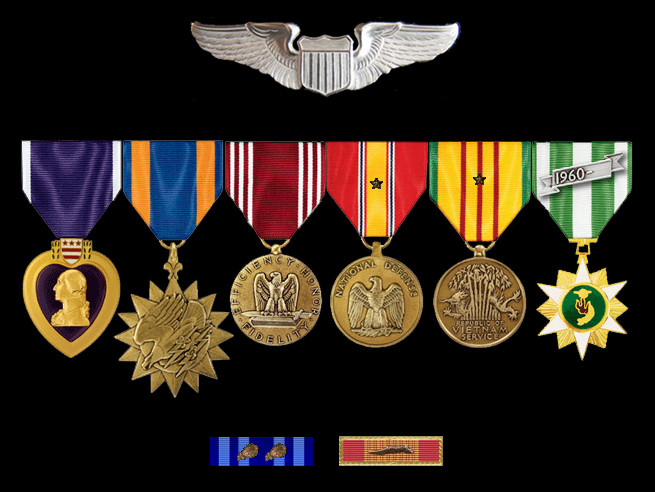
Decorations of Captain Edmund F. Thornell
![]()
The name of Edmund F. Thornell on the
Vietnam Wall in Washington, D.C.
His name is inscribed on Panel 10E Line 065.
Robert "Bob" Babcock
was a Lieutenant and Platoon Leader of 3rd Platoon B Company 1/22
Infantry
in 1966. Bob remembers talking with Captain Thornell on board the
USNS Walker as they both sailed
to Vietnam in July/August 1966. When Captain Thornell was shot
down Lieutenant Babcock was tasked
with the mission of recovering Captain Thornell's body. Bob
Babcock describes the mission which he led
on September 11, 1966:
"It was after 1:00 AM as I
got my briefing from Major High on our morning’s mission. I
was still keyed up
from our harrowing experience of providing relief to our bridge
outpost.
“Yesterday afternoon, between 4:00 and 5:30, one of our
battalion forward air controllers was flying
a reconnaissance mission when his plane went down. The wreckage
was found just before dark.”
“A man was lowered down to it and found the pilot, dead in
the cockpit, and the plane still burning.
We do not know what caused the plane to go down, but we suspect
it was shot down by a .50 caliber machine gun.”
“Your mission is to be there at daylight and bring out the
body. We have only three helicopters available so you
are limited to 24 men, including yourself…,” Major High
continued giving me the details on the terrain and
other items I would need to know to accomplish the mission.
Needless to say, I did not look forward to this next challenge. I
was drained from the mission we had just completed,
I did not like the prospect of running into a .50 caliber machine
gun, and, most of all, I did not look forward to
pulling a burned dead man out of an airplane. My mind could
picture the grotesque sight that would greet me
when I got to the airplane. As usual, I did not get to vote, so
the mission was mine to accomplish.
It was an easy job for me to select the three squads that would
go, Sergeant Benge and his third squad,
Sergeant Burruel and the two machine gun sections from his
weapons squad, and Specialist Muller and his
second squad. Sergeant Roath, Stanley Cameron, my radio operator,
and I would take up three of the slots.
I sent a runner to the perimeter to bring back Muller to join
those of us who were not on perimeter duty.
It turned out the night off for Sergeants Roath, Benge, and
Burruel had been anything but relaxing. At least they
were all sober after the mission to the bridge outpost.
Major High had instructed me to bring my men off the perimeter at
4:30 AM and be ready to get on the helicopters
by 5:30. After briefing my squad leaders, I decided I would try
to get a little sleep. With two hours before we
had to start getting ready, I was convinced some sleep would do
me a world of good.
As soon as I closed my eyes, I could see an image of the pilot in
the burned out cockpit. I tossed and turned
and tried to think of something else but my mind always came back
to what lay ahead of me. After half an
hour, I gave up on sleep, got up, and cleaned my rifle to occupy
my time and my mind. I had never had a job to do
that I dreaded so much. Maybe it was because I knew the pilot (we
had talked frequently during the boat trip to
Vietnam) or maybe my mind was just painting too vivid a horror
picture.
It was still dark as we loaded onto the helicopters. Our
destination was ten miles straight south. The plan
was to land on the beach and work our way inland. Not knowing
where the .50 caliber machine gun was, the helicopters
would not fly over the crash site to let us see what we were
going after. We had to rely on our map, compass, and
high level observation from a helicopter on station above us
after we were safely on the ground.
Just before the helicopters took off, one of the battalion
intelligence sergeants ran up to my chopper and handed me
a Polaroid camera. “Take pictures of the plane and the path
it cut as it crashed. We want to try to determine
what caused the crash and which direction it was coming from as
it crashed.” I really was not thinking of myself as a
photographer that day, I was thinking only of getting in there,
getting the pilot, and getting the hell out.
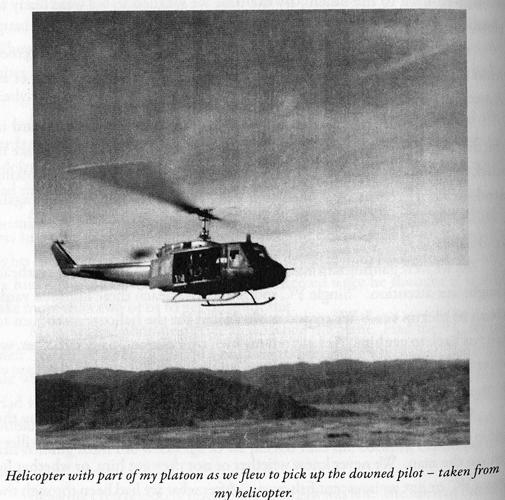
One of the helicopters on the mission to recover the body of Captain Edmund F. Thornell
Photo from WHAT NOW
LIEUTENANT? An Infantryman in Vietnam by Robert O. Babcock,
Deeds Publishing
Company Marietta, GA 2008
We flew at low level over the South China Sea. The pilots
ascended briefly to get their bearings before
they hovered in for a landing on the beach, just a few yards from
where the waves were hitting the sand. It took us
no time to leap from the helicopters and disappear into the
brush, a forty yard sprint away. It was just getting daylight
as we cautiously started working our way inland. The terrain was
rolling sand dunes covered with thick thorn bushes.
One machine gun team set up on the top of a dune to cover the
point squad as they hacked a path through the bushes
that tore at our fatigues. When the point got out of sight of the
covering machine gun, we set up the
other machine gun team on a sand dune and leap-frogged the first
team to be ready to take over again.
After about an hour of slow but steady movement, we had covered
500 yards and could see the crash site.
As we had planned, the three squads formed a defensive perimeter
around the site. Sergeant Roath, Sergeant Benge,
and I had the job of pulling the body out of the plane.
As we had discussed the mission a few hours earlier, Sergeant
Roath was insistent he should do the dirty work
since he had seen so many similar sights during the Korean War. I
could not disagree with his logic and gladly
let him come along. Sergeant Benge volunteered since he thought
it would
take more than two of us to get the pilot out.
My heart was pounding as we approached the plane. Had the VC set
up their .50 caliber machine gun in a position
to fire on the wreckage? The crash site was well within range of
a machine gun set up in the surrounding hills.
Had they been in during the night and booby trapped the airplane?
What would we find in the cockpit of the plane?
A few small wisps of smoke were still coming from the wreckage as
we peered into the cockpit, expecting the worst.
Nothing even remotely resembling a human was left. The fire had
burned intensely and nothing was left
of the pilot’s body but the trunk. The only recognizable
things on the body were his dog tags and a Saint
Christopher’s medal. The thought that crossed my mind was,
“It’s a damned dirty shame anyone had
to die like that.” I just hoped he had been killed by
gunfire and had not burned to death.
Once we knew what we had to deal with, we quickly went to work so
we could get out of there.
As instructed, I took a roll of Polaroid pictures. The close-up
pictures of the bullet holes in the tail of the plane
left no doubt it had been shot down by a .50 caliber machine gun.
We removed the body, zipped it into a body bag, and moved away
from the wreckage. We knew now
there was a .50 caliber machine gun around there somewhere and we
did not want it to find us. Using
the same caution, we moved back to the beach. By the time we
reached it, we were ready to
slump down for a rest.
As I lay on the sand, listening to the waves pound the beach, it
seemed more like a serene vacation spot
than a place that had claimed the life of an American pilot only
a few hours before.
Our rest was short as the sound of the helicopters could be heard
in the distance as they came to extract us.
They radioed for us to pop smoke to mark our location. After
identifying our red smoke, they hovered in,
kicking sand into our faces as we rushed to board. Soon the
choppers were again airborne,
leaving the crash site behind, another grim scar on the
Vietnamese landscape.
As we were gaining altitude, a
radio call from a gunship circling overhead caught our attention.
“Single VC spotted on the beach three hundred yards south of
pickup site.” We tensed as we
waited for the helicopters to turn to take us back to get him. As
I alerted my men over our company
radio net, we were told we were heading back to base camp, the
artillery would take care of him.
Charlie Battery, 4-42 Artillery
responded quickly. As we listened on the radio and watched from
our choppers, they dropped fifty rounds of artillery fire on the
man. We never knew whether or
not they got him.
By 9:00, we were back on the
ground at our base camp. An aid truck met us and took the
pilot’s
body to graves registration. Sergeant Angulo had saved hot
breakfast for us, and the intelligence
section wanted to ask me a thousand questions about what we had
seen and to explain everything
in the Polaroid pictures. Guess who won?
The intelligence people had to
wait on the questions. I was hungry and anxious to hear Sergeant
Angulo and the other rear echelon guys tell their tales about
their mission to the bridge outpost
the previous night. " ¹
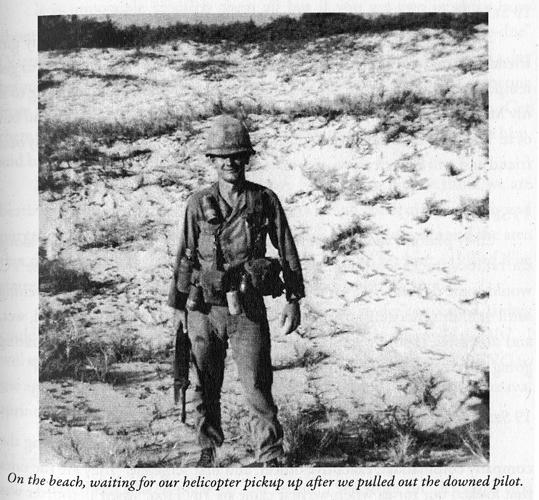
Lieutenant Bob Babcock who led the mission to recover the body of Captain Edmund F. Thornell
Photo from WHAT NOW
LIEUTENANT? An Infantryman in Vietnam by Robert O. Babcock,
Deeds Publishing
Company Marietta, GA 2008
Bob Babcock further wrote:
I was platoon leader of B/1-22
IN who flew to the beach near where Captain Thornell's plane
crashed. We
worked our way to the still smoking wreckage, knowing an enemy
.50 caliber machine gun was in the area. While
our platoon provided security, my platoon sergeant and I removed
his body from the wreckage. We treated the
remains with the respect all American casualties deserve. I never
knew his name until just recently, but will
never forget that mission that was given to me as a rifle platoon
leader.
Bob Babcock and Bill Stevenson
have collaborated on a project to indentify the location of the
crash of Captain Edmund F. Thornell's aircraft. Thanks to the
diligence and persistence of Bill,
the exact grid coordinates of the crash site were discovered.
Bill has prepared a document
containing maps and information about the crash and recovery of
Captain Thornell.
The document can be viewed at the link below. The link is to a
PDF file.
To return to this page, click on the back button in the file.
Click on this link:
The Army, Air Force and Marine FACs in the Vietnam War played an essential role in locating enemy units, coordinating air-ground combat operations, and most critically, managing close air support. The "low and slow" nature of their missions -- typically flown over heavily forested terrain concealing enemy anti-aircraft weaponry -- necessarily involved extraordinary danger, as a result of which their specialty had among the highest casualty rates of the War. To an even greater extent than most who served in Vietnam combat roles, the FAC pilots willingly faced the possibility of a lonely death every day.
Here are additional sources on the role of Forward Air Controllers in the Vietnam War and the 21st TASS:
21st Tactical Air Support Squadron
Forward air control during the Vietnam War
Forward Air Controller - History.net
Edmund F. Thornell was laid to rest on September 20, 1966.
Burial:
Fort Rosecrans National Cemetery
San Diego
San Diego County
California
Plot: PS-6 SITE 562
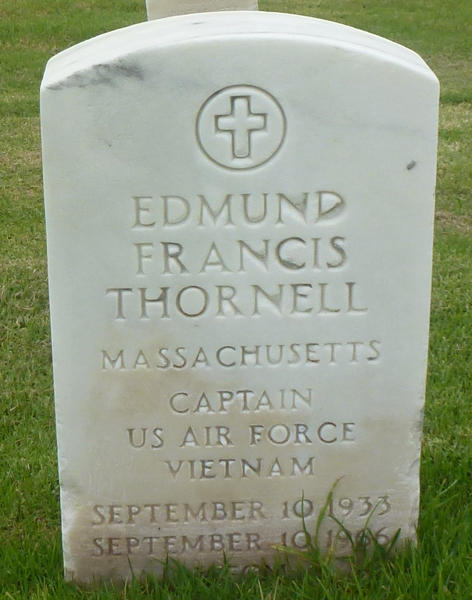
Grave marker for Edmund F. Thornell
Photo by Linda Claxton from the Find A Grave website
¹ WHAT NOW LIEUTENANT? An Infantryman in
Vietnam by Robert O. Babcock,
Deeds Publishing Company Marietta, GA 2008 pp. 104-109
Home | Photos | Battles & History | Current |
Rosters & Reports | Medal of Honor | Killed
in Action |
Personnel Locator | Commanders | Station
List | Campaigns |
Honors | Insignia & Memorabilia | 4-42
Artillery | Taps |
What's New | Editorial | Links |